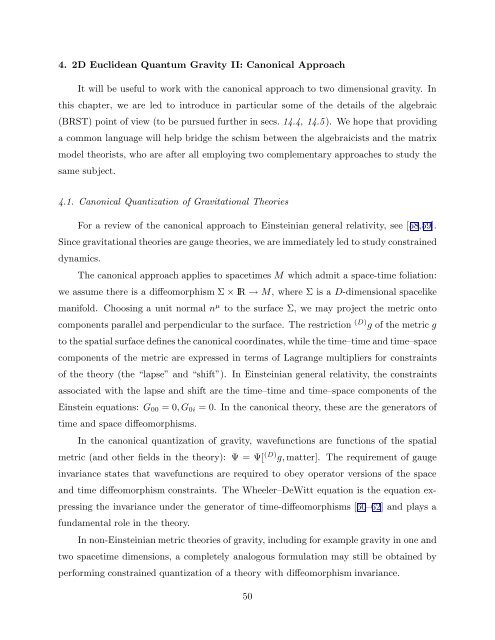arXiv:hep-th/9304011 v1 Apr 5 1993
arXiv:hep-th/9304011 v1 Apr 5 1993
arXiv:hep-th/9304011 v1 Apr 5 1993
Create successful ePaper yourself
Turn your PDF publications into a flip-book with our unique Google optimized e-Paper software.
4. 2D Euclidean Quantum Gravity II: Canonical Approach<br />
It will be useful to work wi<strong>th</strong> <strong>th</strong>e canonical approach to two dimensional gravity. In<br />
<strong>th</strong>is chapter, we are led to introduce in particular some of <strong>th</strong>e details of <strong>th</strong>e algebraic<br />
(BRST) point of view (to be pursued fur<strong>th</strong>er in secs. 14.4, 14.5 ). We hope <strong>th</strong>at providing<br />
a common language will help bridge <strong>th</strong>e schism between <strong>th</strong>e algebraicists and <strong>th</strong>e matrix<br />
model <strong>th</strong>eorists, who are after all employing two complementary approaches to study <strong>th</strong>e<br />
same subject.<br />
4.1. Canonical Quantization of Gravitational Theories<br />
For a review of <strong>th</strong>e canonical approach to Einsteinian general relativity, see [58,59].<br />
Since gravitational <strong>th</strong>eories are gauge <strong>th</strong>eories, we are immediately led to study constrained<br />
dynamics.<br />
The canonical approach applies to spacetimes M which admit a space-time foliation:<br />
we assume <strong>th</strong>ere is a diffeomorphism Σ × IR → M, where Σ is a D-dimensional spacelike<br />
manifold. Choosing a unit normal n µ to <strong>th</strong>e surface Σ, we may project <strong>th</strong>e metric onto<br />
components parallel and perpendicular to <strong>th</strong>e surface. The restriction (D) g of <strong>th</strong>e metric g<br />
to <strong>th</strong>e spatial surface defines <strong>th</strong>e canonical coordinates, while <strong>th</strong>e time–time and time–space<br />
components of <strong>th</strong>e metric are expressed in terms of Lagrange multipliers for constraints<br />
of <strong>th</strong>e <strong>th</strong>eory (<strong>th</strong>e “lapse” and “shift”). In Einsteinian general relativity, <strong>th</strong>e constraints<br />
associated wi<strong>th</strong> <strong>th</strong>e lapse and shift are <strong>th</strong>e time–time and time–space components of <strong>th</strong>e<br />
Einstein equations: G 00 = 0, G 0i = 0. In <strong>th</strong>e canonical <strong>th</strong>eory, <strong>th</strong>ese are <strong>th</strong>e generators of<br />
time and space diffeomorphisms.<br />
In <strong>th</strong>e canonical quantization of gravity, wavefunctions are functions of <strong>th</strong>e spatial<br />
metric (and o<strong>th</strong>er fields in <strong>th</strong>e <strong>th</strong>eory): Ψ = Ψ[ (D) g, matter]. The requirement of gauge<br />
invariance states <strong>th</strong>at wavefunctions are required to obey operator versions of <strong>th</strong>e space<br />
and time diffeomorphism constraints. The Wheeler–DeWitt equation is <strong>th</strong>e equation expressing<br />
<strong>th</strong>e invariance under <strong>th</strong>e generator of time-diffeomorphisms [60–62] and plays a<br />
fundamental role in <strong>th</strong>e <strong>th</strong>eory.<br />
In non-Einsteinian metric <strong>th</strong>eories of gravity, including for example gravity in one and<br />
two spacetime dimensions, a completely analogous formulation may still be obtained by<br />
performing constrained quantization of a <strong>th</strong>eory wi<strong>th</strong> diffeomorphism invariance.<br />
50
















